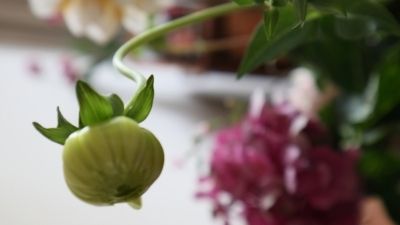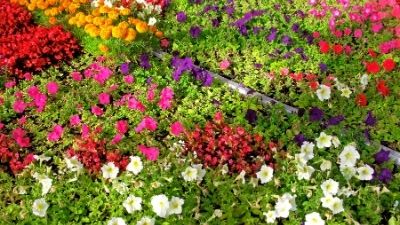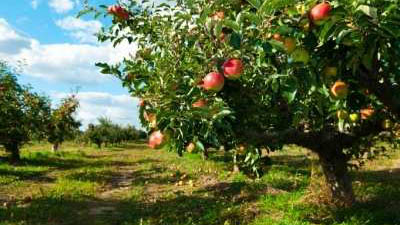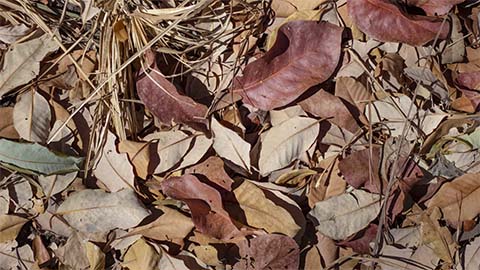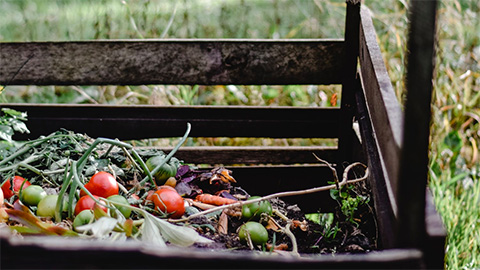Designing a Basic PVC Home Garden Drip Irrigation System
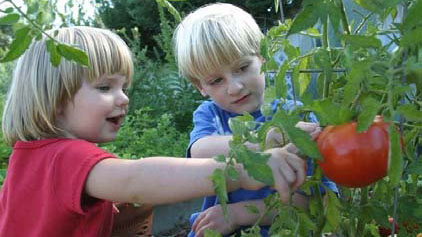
Gardening
People of all ages enjoy the benefits of gardening, ranging from producing high quality produce to working with the soil. Due to water costs, and increasing water demands, gardeners need to be concerned about conservation. One effective way to conserve water is by utilizing drip irrigation.
Drip Irrigation
Drip irrigation is a method which reduces the use of water by allowing water to drip slowly to the roots of plants, either onto the soil surface or directly onto the root zone, through a network of valves, pipes, tubing, and emitters. There are many advantages of using drip irrigation. These include:
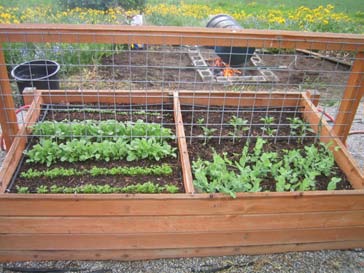
Raised bed using drip irrigation
- Water savings, since only those areas directly around plant root zones are irrigated.
- Plants undergo less stress from variations in soil moisture.
- Slow application rate prevents excess surface water build-up and reduces evaporation.
- Weed growth is reduced because areas between plants are not irrigated.
- System can be designed for use in all types of terrain and soil conditions.
- Low flow rate allows irrigation of larger areas and more plants can be watered at once.
These and other benefits are only possible to the user when a drip irrigation system is properly de-signed, managed, and maintained.
Juab County Drip System
Gardeners in Juab County designed a drip irrigation system that is simple, user friendly, easy to man-age, and effective. The system can be designed to accommodate nearly every type of garden situation. People should design a system that works best for them. The Juab County Drip Irrigation System can be modified for different types of applications in-cluding raised beds, greenhouses, fruit trees, and traditional gardens.
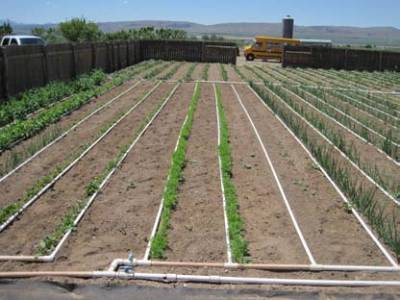
PVC drip irrigation example
System Design
The system uses ½, ¾, or 1 inch PVC pipe, fittings, and manual valves. Depending on care, life expec-tancy of the materials is 10 to 12 years. All lines and fittings, before the manual valves, are glued to handle high water pressure. Lateral lines are not glued to make the system flexible in row place-ment. Lateral lines can be changed and moved quite easily depending on the type of plants grown.
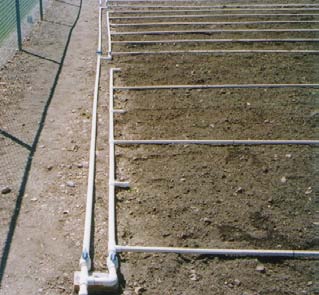
Main distribution lines are glued,lateral lines are not glued
Valves, Water Output, Plugs, and End Caps
One problem gardeners experience with their irri-gation system is controlling flow rate and high wa-ter pressure. With this system, manual ball valves are used to control flow rate and assist in reducing pressure. The number of lateral lines that can be used with this system will vary a great deal. It will depend on several factors including the irrigation source flow rate and pressure, length of main and lateral lines, and the desired per hole water output. As gardeners use this system, they will learn how to manage their system to maximize water output.
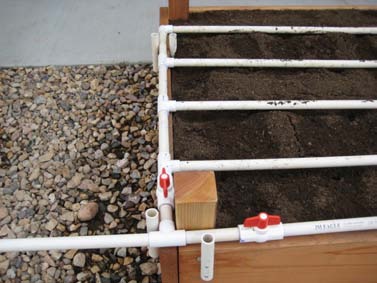
Manual valves control flow rate andassist in reducing pressure
Plugs are used to eliminate water flow in non-irrigated row areas. End caps are used on the end of each lateral line to force the water through irri-gation holes. The caps are not glued for the ease of cleaning the system.
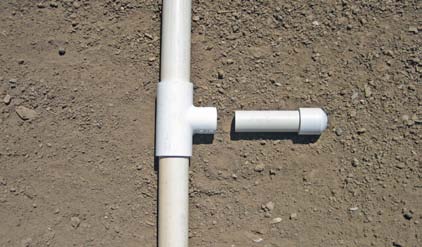 Plugs are used to eliminate wateringnon-irrigated rows
Plugs are used to eliminate wateringnon-irrigated rows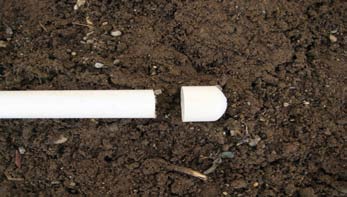 End caps are not glued for ease ofcleaning the system
End caps are not glued for ease ofcleaning the system
Hole Size and Spacing
Hole size is one of the keys to the success of the system. A 1/16 inch hole is the desired size. It is large enough to let soil particles pass through, but small enough for correct flow rate. To drill the holes in the lateral lines, the following equipment is needed: drill, tape measure, marking pen, and 1/16 inch drill bit. For convenience when drilling holes, place the pipe on some type of stand, such as tables placed end to end.
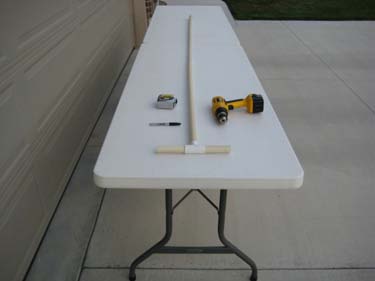 Equipment used
Equipment used
Lateral irrigation lines and individual hole spacing will depend on the users garden plan for the current year. For plants such as corn, carrots, and peas, the holes are spaced every 6 inches. For plants such as watermelons, tomatoes, and pumpkins, the holes are spaced in groups of three, 2 to 3 inches apart. The spacing for each plant group can vary between 3 and 5 feet. This will depend on the suggested plant spacing requirements.
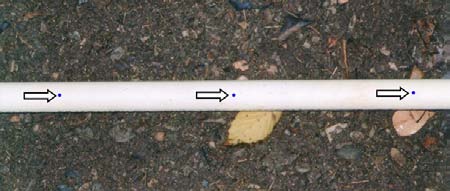
For corns, beans, etc., 1/16 inch hole drilled every 6 inches
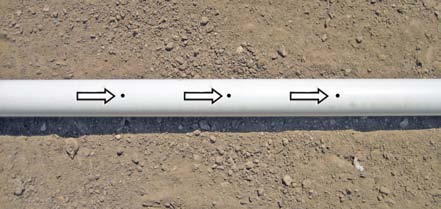
For squash, tomatoes, etc., 3-1/16 inch holes
drilled 2-3 inches apart and every 3 to 5 feet
Nutrient Requirements
One of the essential elements of a successful garden is being able to meet the nutrient requirements of the plants during the season. The first step in creating fertile garden soil is to determine current nutrient needs. Soil testing information is available at your local Extension office. There are different types of fertilizers available to the home gardener. These include both chemical and organic fertilizers. There are also different methods of applying fertil-izers including injectors, foliar feeding, side dress-ing, banding, and broadcasting. The Juab County Drip Irrigation System can be used with most ap-plication methods, but the best results will be achieved by using some type of injector. Injectors can use either dry or liquid water-soluble fertilizer. By using an injector with this drip system, a gar-dener can control the quantity of fertilizer applied to meet the nutrient requirements of the different plants.

Fertilizer injector
Beginning of Season
Before planting, the entire system should be laid out and tested, which involves flushing out the main line and laterals with water, end caps re-moved. Next, install all end caps, and with the holes facing up, turn on the water and clean out any plugged hole with a piece of wire. After testing the system, the holes can be turned up or down. For lateral lines with holes facing up, drill a drainage hole on the bottom every 2 to 3 feet. 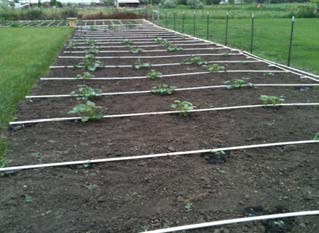
Dale Lisby - Utah
For the best results in using this system, the ground should be level. To compensate for non-level ground, using items like leveling stakes installed at different heights and intervals will help make the lateral lines as level as possible.
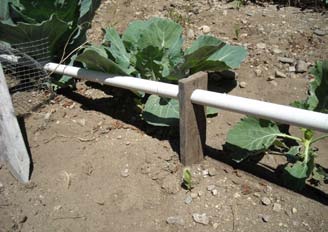
Leveling stake
Drip System Benefits
By using this system, users will enjoy several bene-fits. Water savings: in different studies, home owners noticed water savings of up to 75%. Time savings: in the same studies, the participants ex-perienced up to 90% time savings in watering and weeding the gardens. Throughout the growing sea-son, the study participants observed that the plants were healthier and produced at a higher level.

Richard and Kathy Walter - California
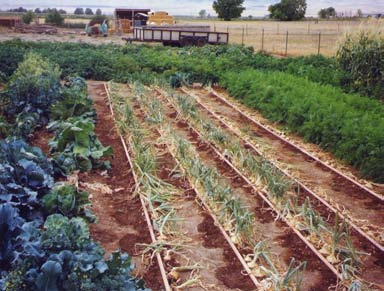
Brent Taylor - Utah
Summary
Drip irrigation can help home gardeners enjoy the benefits of gardening. By using drip irrigation, gardeners will spend less time weeding and water-ing, will notice water savings, and enjoy higher production. The Juab County Drip Irrigation Sys-tem is simple to design, user friendly, and highly effective. Using this system can add to the enjoy-ment and satisfaction of raising gardens.
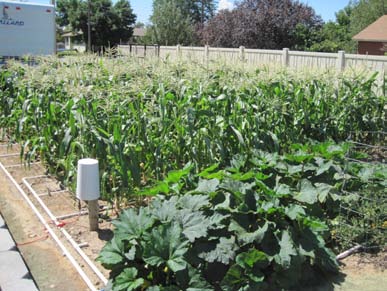
Jeff Banks - Utah
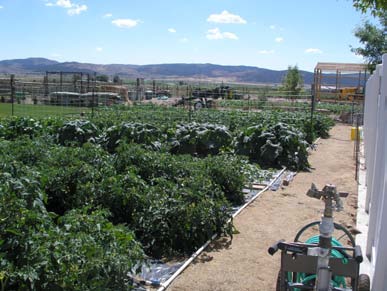
Chris Rosenkrantz - Utah
Acknowledgments: The author would like to thank the following for use of their photos in this publi-cation: Jeff Banks, EZ-FLO, Charles Gay, Dale Lisby, Chris Rosenkrantz, Brent Taylor, Richard and Kathy Walter.
For more information about this drip irrigation system, contact Jeffrey E Banks, USU Extension Agent in Juab County, 160 North Main, Nephi, UT 84648. Phone: 435-623-3452. Email: jeff.banks@usu.edu. Juab County website: extension.usu.edu/juab.
Published May 2012
Utah State University Extension
Peer-reviewed fact sheet
Download PDF
Authors
Jeffrey E Banks, USU Extension Agent, Juab County
Related Research


